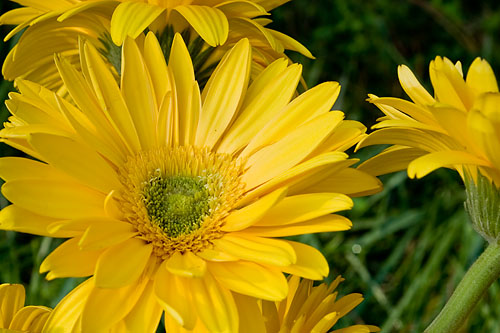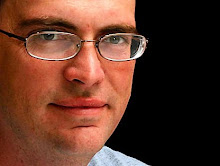
| 1/30 | f11 | ISO 100 | 55mm | RAW |
I got out early Sunday to get some flower photos in the morning sun. I set my camera on a tripod and used my Canon EF-S 18-55mm f3.5-5.6 IS lens, which is also a decent macro lens.
Don't know what macro photography is? Don't worry — a lot of people don't. Simply put, macro photography is the art of taking closeup photos of small things, which allows you to see details not easily seen with the naked eye.
Using a tripod is vital for this kind of shot. As my friend Brian pointed out in one of his comments, the closer something is when you focus on it, the narrower the depth of field is. So in the instance of these daisies, they were about 10 inches from the lens. To get a deep enough depth of field, I needed to close the aperture down to f11.
I could have bumped up the ISO from 100 to 200 (which would have doubled the shutter speed from 1/30 to 1/60), but I wanted to have the cleaner image that ISO 100 would produce. Also, when you are hand-holding the camera at these short focus distances, a slight sway of a half-inch forwards or backwards can totally ruin the focus. Even at f11, you are dealing with such a narrow depth of field that a tripod is vital to hold the camera steady — not only because of the slow shutter speed, but also because you want an exact spot for the focus.
I shot this a little wide to give myself optimum flexibility when cropping the photo in Photoshop. This particular crop shows about half of the photo. I chose to crop it this way to implement the rule of thirds by putting the center of the flower a third of the way into the photo.
If you would like to try this with your camera, there are two options: most point-and-shoot cameras have a macro mode (which is usually represented by a flower icon) or, if you have a DSLR, you can buy a macro lens, which is specially designed to focus on items only a few inches away.
Point-and-shoot cameras can be great for macros since many of them will let you focus as close as two or three inches from the lens. As for DSLRs, some of the newest kit lenses (the one that might have come with your camera) will do for macros in a pinch because they also have a very short minimum focal range. For instance, the lens I used can focus to within five inches.
A couple of notes of warning, however. First, dedicated macro lenses (and point-and-shoot cameras set to macro mode) will have a focus range of only a few inches to a few feet. If you try to focus on something more than three feet away, your lens probably won't be able to. Second, this kind of work is best done under controlled circumstances. The more things that are out of your control (like wind and inconsistent sunlight), the more you will have to work. These flowers were actually in a vase, so as the sunlight moved through the trees I had to move the vase several times to keep it in the light
As for what I don't really like in the photo, there is a hot-spot nearly dead center where the detail in the yellow is lost in one petal. Also, I wish I had gotten the tips of the petals at the bottom of the photo in more focus.





2 comments:
this picture is gray, or low contrast
my photo teacher would actually over expose sunflowers by 1 or 2 stops to get to the flowers to not be so zone V based on Adam's Zone System. You might even try using an off the camera flash to increase the contrast (this might always make it so you could use like f22)
Brian, you're right! I went back and added some contrast and the photo looked much better. Thanks.
Post a Comment